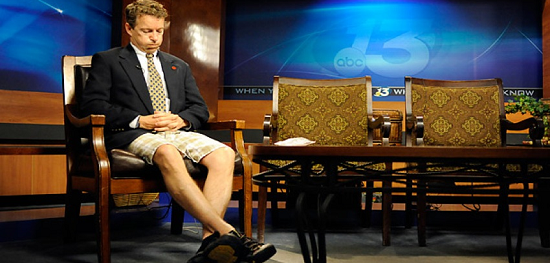 |
| Hillary Clinton laughs with ex-Sec. of Defense Leon Panetta. A recent CNN/ORC poll certainly gives her plenty reason to smile. Photo courtesy of Win McNamee/Getty Images |
Still shaking off the sting of November's thumping, a recent CNN/ORC poll provided Democrats with some glimmers of hope. While most of the headlines generated by the poll were concerned with Obama's sudden surge in job approval, there was another eye-brow raising statistic in the release - Hillary Clinton positively dominates the entire 2016 Republican field, at a time when news of Jeb Bush's unofficial campaign launch has sucked up much of the media oxygen in the room.
So how does the recently much-hyped junior Bush stack up against the recently quiet ex-Secretary of State? Very poorly, actually.
If the election were held today, Hillary would win a clear majority of the vote (54%), while Jeb Bush just barely cross the 40% mark. Supposing the margin between the candidates holds, it would be the worst popular vote performance for Republicans in a Presidential election since Barry Goldwater's landslide 1964 loss.
And if Jeb Bush is not the Republican nominee, and you're a Republican voter, well...go ahead and bend over, per CNN, because 2016 is going to be a rough ride.
The tough-talking New Jerseyan, who most think is a shoe-in to run, trails Hillary by an embarrassing 56-39% margin. Candidates as diverse as Rand Paul, Mike Huckabee, and Ted Cruz, all trail ex-Sen. Clinton by 20 points or more. Hillary even hits 60% in a head-to-head against Sen. Cruz.
If you buy the CNN/ORC numbers, Hillary's performance against all of these candidates is truly intimidating. Not only does she match her ex-two-term President husband's 1990s performance in many demographic metrics, she actually exceeds his showing in many more. Consider the table below, which documents the demographics in which Hillary Clinton performs exceptionally strong in the CNN poll, and compares her performance with past Democratic nominees for President dating back to 1972 (the beginning of the modern exit polling era).
 |
| Exit Poll data courtesy of Best & Krueger's Exit Polls. |
Clinton's performance against Jeb Bush among men, women, Democrats, and Independents, is the best performance for any Democratic presidential nominee since at least as far back as national exit polls track (1972). In other words, Hillary Clinton outperforms EVERY Democrat dating back to McGovern, in key demographics tested by the CNN/ORC poll. For example, she's up four among men, a feat not yet accomplished by any Democrat in exit polling to date. Only Bill Clinton came close to such an accomplishment when he carried the male vote by 3 points in 1992. But even then, that election is not directly comparable due to the unique strength of third-party candidate Ross Perot.





















